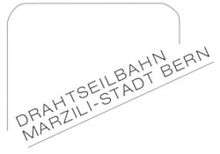Marzili Funicular
| Drahtseilbahn Marzili-Stadt Bern | ||||||||||||||||||
|---|---|---|---|---|---|---|---|---|---|---|---|---|---|---|---|---|---|---|
 | ||||||||||||||||||
 A Marzilibahn car, 2008 | ||||||||||||||||||
| Overview | ||||||||||||||||||
| Type | Funicular | |||||||||||||||||
| System | Libero, Bern area transport network | |||||||||||||||||
| Locale | Bern, Switzerland | |||||||||||||||||
| Coordinates | 46°56′44″N 7°26′33″E / 46.94556°N 7.44250°ECoordinates: 46°56′44″N 7°26′33″E / 46.94556°N 7.44250°E | |||||||||||||||||
| Stations | 2 | |||||||||||||||||
| Website | www.marzilibahn.ch | |||||||||||||||||
| Operation | ||||||||||||||||||
| Opened | 18 July 1885 | |||||||||||||||||
| Operator(s) | Drahtseilbahn Marzili-Stadt Bern AG | |||||||||||||||||
| Technical | ||||||||||||||||||
| Line length | 105 metres (115 yd) | |||||||||||||||||
| Track gauge | 750 mm (2 ft 5 1⁄2 in) | |||||||||||||||||
| Operating speed | 3 m/s (9.8 ft/s) | |||||||||||||||||
| ||||||||||||||||||




The Marzilibahn, officially the Drahtseilbahn Marzili–Stadt Bern (Funicular Marzili–City of Bern) is a very short funicular in Bern, the capital of Switzerland. Its 105 meters of track lead from the Marzili neighbourhood to the Bundeshaus, the seat of the Swiss federal government and parliament, in the Old City of Bern.
History
The Marzilibahn was proposed by a committee of seven Bernese entrepreneurs, who received an 80-year operating license by the Swiss Federal Assembly on 13 December 1884. Construction began in March 1885 and was hastily completed to allow a start of operations on 19 July 1885, to coincide with the opening of the Eidgenössisches Schützenfest, the Swiss marksmen's festival, in Bern.[1] As originally built, the tracks had a length of 112 metres (122 yd) and spanned a height difference of 31 metres (34 yd).[2]
The cars were water-powered: a tank in the upper car was filled with up to 3.5 tonnes (3.4 long tons; 3.9 short tons) of water from the city stream (Stadtbach). This car, being heavier, then pulled the other one up the slope, after which the water would be drained and the process repeated with the other car. Up to thirty persons could be transported upwards in this manner. The descent was controlled by an operator on the forward platform on the upper car, who communicated with his colleague in the lower car by means of bell signals.[3]
The original green cars, built by the local machine company Pümpin & Herzog (later part of Von Roll) were replaced in 1914 by a new set of cars on account of the Swiss national exhibition in Bern, and the official name of the funicular was changed from Drahtseilbahn Aarziele to Drahtseilbahn Marzili-Stadt Bern. Ticket prices ranged from 10 rappen at the time of the opening (the Federal Council had to forbid charging non-locals twice that much) to 30 rappen in 1973.[4] The area around and below the raised steel tracks was a garden, cared for by the conductors.[5]
In 1974, the line was converted to electric power, and a third generation of cars supplied. The two second generation cars are both preserved, one at the Swiss Museum of Transport in Lucerne and the other close to the lower station of the line.[6]
Technical parameters
The funicular has the following parameters:[7][8]
| Number of cars | 2 |
| Number of stops | 2 (at terminals) |
| Configuration | Single track with passing loop |
| Track length | 105 metres (344 ft) |
| Rise | 32 metres (105 ft) |
| Maximum gradient | 32% |
| Track gauge | 750 mm (2 ft 5 1⁄2 in) |
| Maximum speed | 3 metres per second (9.8 ft/s) |
| Travel time | 1 minute |
| Capacity | 30 persons per car |
Records
The Marzilibahn is sometimes called the shortest funicular in Europe, but its operators are not certain about this, noting that similarly short funiculars exist in England and Hungary.[9] The Zagreb Funicular in Croatia is at any rate shorter at 66 m. The shortest non-public funicular in Switzerland is an 85 m installation belonging to the Hotel Montana in Lucerne.[9]
Operator
The Marzilibahn is owned and operated by a private company, Drahtseilbahn Marzili-Stadt Bern AG, which employs ten part-time staff. Its shares are held mostly by railway enthusiasts.[9] In 2009, the company turned a profit of 175,000 Swiss francs.[10]
See also
References
- ↑ Heimann, 7-15.
- ↑ Heimann, 32.
- ↑ Heimann, 25-28.
- ↑ Heimann, 32-33.
- ↑ Heimann, 42.
- ↑ "Geschichte" [History] (in German). Marzilibahn. Retrieved 4 July 2013.
- ↑ "DMB - Drahtseilbahn Marzili - Stadt Bern". Funimag. Retrieved 4 July 2013.
- ↑ "DMB Drahtseilbahn Marzili-Stadt Bern AG" (PDF) (in German). Marzilibahn. Retrieved 4 July 2013.
- 1 2 3 "Marzilibahn wird 125-jährig". Berner Zeitung. 16 July 2010. Retrieved 16 July 2010.
- ↑ "News Feed SmallCaps: Drahtseilbahn Marzili" (in German). Berner Kantonalbank. 23 June 2010. Retrieved 16 July 2010.
Bibliography
- Heimann, Alexander E. (1974). D Marzilibahn. Viktoria-Verlag.
External links
-
 Media related to Marzilibahn at Wikimedia Commons
Media related to Marzilibahn at Wikimedia Commons - Official web site of the Marzilibahn